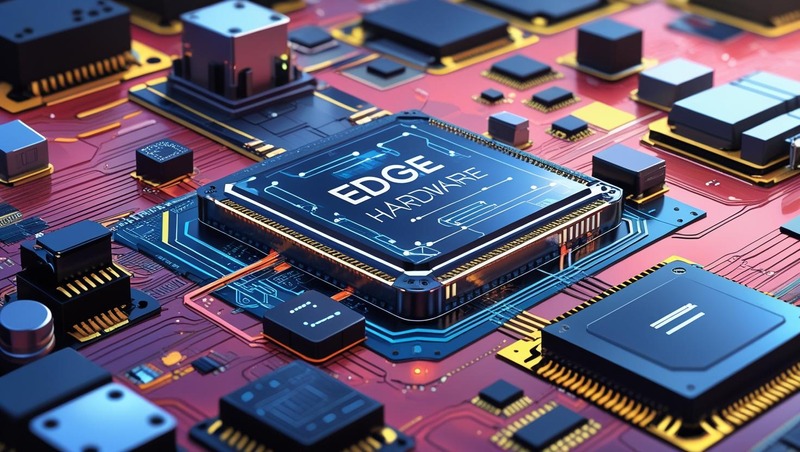Edge AI hardware is poised to experience remarkable growth in the coming years, driven by the increasing demand for real-time data processing, enhanced privacy, and decentralized intelligence in connected devices. As industries continue to embrace digital transformation and integrate AI-powered solutions into everyday operations, edge AI hardware is emerging as a foundational enabler of the next wave of innovation in IoT, automation, and intelligent computing.
The global edge AI hardware market is expected to grow at a compound annual growth rate (CAGR) of over 20% through the end of the decade. This growth is fueled by the rising adoption of smart applications in sectors such as automotive, manufacturing, healthcare, agriculture, and consumer electronics. As more devices become intelligent and connected, the need to process data closer to where it is generated—at the edge—is becoming increasingly critical. Edge AI hardware allows devices to analyze and act on data locally, reducing the reliance on cloud infrastructure, minimizing latency, and enhancing the responsiveness of real-time applications.
Download PDF Brochure @ https://www.marketsandmarkets.com/pdfdownloadNew.asp?id=158498281

One of the key drivers of future growth is the advancement in semiconductor technologies. Major chipmakers are investing heavily in the development of high-performance, low-power AI processors optimized for edge environments. Companies like NVIDIA, Intel, AMD, Qualcomm, and Apple are continuously pushing the boundaries of AI chip design, introducing system-on-chip (SoC) solutions, AI accelerators, and neural processing units (NPUs) that bring powerful AI inference capabilities to mobile devices, embedded systems, and industrial equipment. As these components become more energy-efficient, compact, and affordable, the barriers to deploying edge AI across diverse use cases are steadily diminishing.
Another factor contributing to the expansion of the edge AI hardware market is the rollout of 5G networks. With ultra-low latency and high-speed data transmission, 5G enables seamless connectivity for billions of IoT devices while complementing edge computing infrastructure. This creates an ideal environment for edge AI systems to thrive, particularly in applications requiring instantaneous decision-making such as autonomous driving, smart surveillance, drone navigation, and remote healthcare diagnostics.
Moreover, the proliferation of smart sensors and embedded AI solutions is expected to accelerate growth in edge AI hardware. From wearable health trackers to smart home assistants and industrial robots, embedded AI chips are enabling context-aware computing that can operate even in remote or bandwidth-constrained environments. This shift toward localized intelligence is particularly relevant in scenarios where data privacy, regulatory compliance, or network availability are of concern.
In the coming years, edge AI hardware is also expected to play a critical role in the evolution of Industry 4.0 and smart manufacturing. By enabling predictive maintenance, anomaly detection, quality control, and process optimization directly on the factory floor, edge AI is helping businesses reduce downtime, improve productivity, and enhance overall operational efficiency. These benefits are making edge AI an indispensable component of modern industrial ecosystems.
Despite the promising outlook, the future of edge AI hardware will also depend on addressing key challenges such as standardization, interoperability, and software-hardware integration. The ecosystem is still maturing, and ensuring seamless communication and scalability across devices from different vendors will be essential. Furthermore, developers will need robust tools and frameworks to efficiently train and deploy AI models on resource-constrained edge devices.
Frequently Asked Questions (FAQs) on the Edge AI Hardware Market
1. What is Edge AI Hardware?
Edge AI hardware refers to specialized chips, processors, and devices designed to perform artificial intelligence tasks locally—at or near the data source—rather than relying on cloud computing. These include AI accelerators, GPUs, NPUs, and microcontrollers that enable faster, real-time processing with lower latency and enhanced data privacy.
2. How is Edge AI Hardware different from traditional AI hardware?
Unlike traditional AI hardware that depends on cloud infrastructure for data processing, Edge AI hardware processes data locally, minimizing the need for constant internet connectivity. This approach significantly reduces latency, increases response speed, and ensures greater privacy, especially in applications like autonomous vehicles, industrial automation, and healthcare.
3. What are the key drivers of the Edge AI Hardware market?
The key growth drivers include rising demand for real-time decision-making, growth in IoT and smart devices, increasing edge deployments across sectors like automotive and manufacturing, and the need for low-latency, high-efficiency AI processing. Additionally, the rollout of 5G and improvements in chip architectures are propelling market growth.
4. Which industries are adopting Edge AI Hardware the most?
Industries like automotive (especially in ADAS and autonomous vehicles), industrial automation, healthcare (for diagnostics and monitoring), retail (for in-store analytics), smart cities, and consumer electronics are rapidly adopting Edge AI hardware for its ability to provide quick, localized insights and automation.
5. What are the challenges facing the Edge AI Hardware market?
Challenges include high development and integration costs, power efficiency limitations for compact devices, hardware fragmentation, and complexity in deploying AI models on resource-constrained edge devices. Ensuring security and managing edge-to-cloud orchestration are also critical concerns.
See The Latest Semiconductor Reports:
Embodied AI Market by Product Type [Robots (Humanoid Robots, Mobile Robots, Industrial Robots, Service Robots, Cobots), Exoskeletons, Autonomous Systems, Smart Appliances], Level of Embodiment (Level 1, Level 2, Level 3) – Global Forecast to 2030
Photovoltaics Market by Material (Silicon, CIGS, CdTe, Perovskite, Organic Photovoltaic, Quantum Dot), Component (Modules, Inverters, BOS), Installation Type (Ground-mounted, Building-integrated, Floating), Cell Type and Region – Global Forecast to 2030